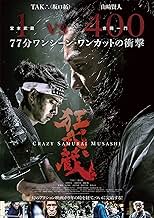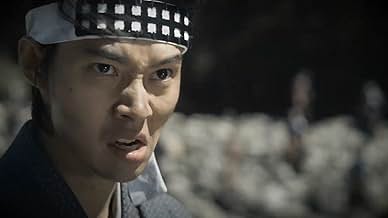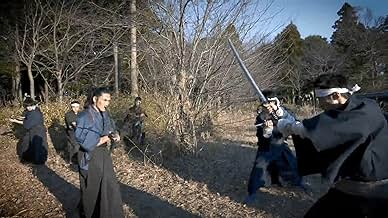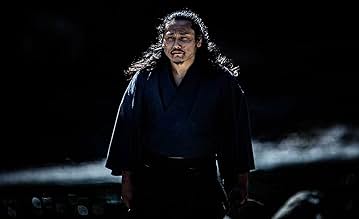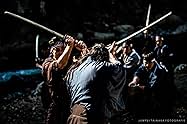IMDb-BEWERTUNG
4,6/10
1059
IHRE BEWERTUNG
Füge eine Handlung in deiner Sprache hinzuThe most famous battle of the swordsman Miyamoto Musashi. Miyamoto fights against 588 enemies, one after the other. There is no room for error, no room for trivial, outdated, or unconvincing... Alles lesenThe most famous battle of the swordsman Miyamoto Musashi. Miyamoto fights against 588 enemies, one after the other. There is no room for error, no room for trivial, outdated, or unconvincing movements.The most famous battle of the swordsman Miyamoto Musashi. Miyamoto fights against 588 enemies, one after the other. There is no room for error, no room for trivial, outdated, or unconvincing movements.
Empfohlene Bewertungen
Miyamoto Musashi was a very interesting Japanese Ronin in Japan's era's of swordsmen and Samurai history. Throw in Tak Sakguchi playing Musashi and I was all set for an amazing action film. How wrong I was!
It dragged on and on with poor fight choreography and too few extras playing his enemies (it became very apparent, after 10 minutes, that the same dead guys were coming back time and time again). There were no exiting moments, no edge of your seat grippers but, there were many sword style errors; which in real life he would have been killed.
Overall i think it was poorly conceived, directed and acted with terrible choreography.
A brief HISTORY of the warrior who was the Bruce Lee of ancient Japanese swordsmen. Miyamoto Musashi, also known as Shinmen Musashi no Kami Fujiwara no Harunobu, Shinmen Takezo, Miyamoto Bennosuke or, by his Buddhist name, Niten Doraku, was a Japanese swordsman, philosopher, strategist, writer and Ronin. Musashi, as he was often simply known, became renowned through stories of his unique double-bladed swordsmanship and undefeated record in his 61 duels. He is considered a Kensei, a sword-saint of Japan. He was the founder of the Niten Ichi-ryu, or Nito Ichi-ryu, style of swordsmanship, and in his final years authored The Book of Five Rings and Dokkodo. Both documents were given to Terao Magonojo, the most important of Musashi's students, seven days before Musashi's death. The Book of Five Rings deals primarily with the character of his Niten Ichi-ryu school in a concrete sense, i.e., his own practical martial art and its generic significance; The Path of Aloneness, on the other hand, deals with the ideas that lie behind it, as well as his life's philosophy in a few short aphoristic sentences. Born:Shinmen Bennosuke, c.1584, Harima Province or Mimasaka Province, Japan. Died:June 13, 1645, Higo Province, Japan.
A brief HISTORY of the warrior who was the Bruce Lee of ancient Japanese swordsmen. Miyamoto Musashi, also known as Shinmen Musashi no Kami Fujiwara no Harunobu, Shinmen Takezo, Miyamoto Bennosuke or, by his Buddhist name, Niten Doraku, was a Japanese swordsman, philosopher, strategist, writer and Ronin. Musashi, as he was often simply known, became renowned through stories of his unique double-bladed swordsmanship and undefeated record in his 61 duels. He is considered a Kensei, a sword-saint of Japan. He was the founder of the Niten Ichi-ryu, or Nito Ichi-ryu, style of swordsmanship, and in his final years authored The Book of Five Rings and Dokkodo. Both documents were given to Terao Magonojo, the most important of Musashi's students, seven days before Musashi's death. The Book of Five Rings deals primarily with the character of his Niten Ichi-ryu school in a concrete sense, i.e., his own practical martial art and its generic significance; The Path of Aloneness, on the other hand, deals with the ideas that lie behind it, as well as his life's philosophy in a few short aphoristic sentences. Born:Shinmen Bennosuke, c.1584, Harima Province or Mimasaka Province, Japan. Died:June 13, 1645, Higo Province, Japan.
This is a Japanese movie? But calling it a movie is a stretch. Also apart from a exposition dump in the first 5 minutes there is about 10 lines so not that much Japanese in it. They spend over an hour with one samurai guy taking on an endless supply of stunt guys. Poor quality you could find better quality at a medieval fair show. To be fair they do slowly walk through a model Japanese village during it. It's boring what can I say how long does it take watching Japanese men struggling out of shot after being sliced then to immediately join the endless supply of grunts. It feels like a beat them up video game without any inputs and it's stuck in an endless cutscene which never ends.
Personally I enjoyed the movie, but to review this or recommend the movie, I would not.
I had no idea Tak was the leading actor, and I knew it would not disappoint. Though it let me down.
The opening of the movie felt like a real movie, the camera, cinematography, colour grading, blurring etc. As soon as someone gets killed and Musashi reveals himself, then the quality all of a sudden drops.
I was shocked that the movie did the action one take with no cuts, effects or cgi. However it got repetitive, which was the movie's downfall. Same moves, same attacks, same sequences. I can understand it would be hard to find 400 actors and 400 actors who can remember the choreography and cut time, so it's fine for me if the same actors where repeating.
The movie had little story, which was a downfall, we have no idea why Musashi is killing the clans or why they want to kill him (because he killed someone Sejuiro). The effects of the movie are actually quite good, blood is not over exaggerated, but believeable.
The one shot take was cool, but very boring. I was just surprised how Tak could go on and on, which was an impressive human feat, this should go on the Guinness Book of World Record. Music were good choice, there was lack of acting.
The ending fight scene felt better than all the 70mins 1shot take.
Would I recommend this movie? No.
But I would advise you to watch if you like Samurai, Tak or one shot takes.
I had no idea Tak was the leading actor, and I knew it would not disappoint. Though it let me down.
The opening of the movie felt like a real movie, the camera, cinematography, colour grading, blurring etc. As soon as someone gets killed and Musashi reveals himself, then the quality all of a sudden drops.
I was shocked that the movie did the action one take with no cuts, effects or cgi. However it got repetitive, which was the movie's downfall. Same moves, same attacks, same sequences. I can understand it would be hard to find 400 actors and 400 actors who can remember the choreography and cut time, so it's fine for me if the same actors where repeating.
The movie had little story, which was a downfall, we have no idea why Musashi is killing the clans or why they want to kill him (because he killed someone Sejuiro). The effects of the movie are actually quite good, blood is not over exaggerated, but believeable.
The one shot take was cool, but very boring. I was just surprised how Tak could go on and on, which was an impressive human feat, this should go on the Guinness Book of World Record. Music were good choice, there was lack of acting.
The ending fight scene felt better than all the 70mins 1shot take.
Would I recommend this movie? No.
But I would advise you to watch if you like Samurai, Tak or one shot takes.
I appreciate a good gimmick and an indie film that tries to go big, but this was just exhausting. The reason anyone will watch Crazy Samurai Musashi is the 70 something minute long one-shot action scene that stretches from the opening title almost to the very end. Unfortunately the very same scene is the movie's biggest downfall.
I will cut this movie a lot of slack. Obviously there wasn't a big budget and they had to squeeze every penny very hard. The talent on display here is generally fantastic, especially from main actor Tak Sakaguchi whose other roles I shall immediately seek out, the scenery is used well and very plausible. The choreography is deliberately non-flashy and rather realistic which I appreciate as a pupil of japanese swordsmanship myself. The one-shot action scene however wasn't the most compelling choice to show all of this talent off.
Every passing minute it becomes increasingly apparent how the scene was done as not only individual move lists get recycled like a standard fighting animation in a videogame, but rather entire sections of choreography. There's also a lot of obvious body armor on the stunt guys. I got most of my entertainment value from guessing the next move. Someone's looking suspiciously bulky? Belly cut! Someone's wearing a very obvious big hair wig? Gee I wonder who's getting hit in the head. Then there's the same guy who always stumbles into frame, gets tripped and cut in the back while falling. The lack of extras is a very glaring flaw. Everytime someone gets killed he literally runs out of frame to re-emerge unharmed a few moments later. It was laughably ridiculous. When enemies eventually stop running out of frame and stay on the ground you know this particular segment is about to end, our hero moves on to the next level segment where clones of the exact same guys will show up a minute later, circle around him and attack one at a time with the same pattern. Rinse and repeat for 70 minutes.
Now I understand the limitations at play here but they are rather unnecessary and self-inflicted. Had this been shot in a more conventional manner it would have been no problem to shoot and edit around them entirely and make for a more compelling, even enthralling movie. For all of its gimmicky glory the one-shot is used very amateurishly too. A lot of the action is constantly obscured by extras and the camera never moves in interesting and creative ways. The opening 30 minutes of the recent super smash hit One cut of the dead (which I assume was the inspiration) showed what fun you could have with a creative one-shot action scene. This movie felt like a chore by comparison. It just goes on and on without any tension or escalation. It's still an impressive and admirable feat, but ambition alone doesn't make a good film.
To add insult to injury the film ends in a legitimately spectacular (albeit obviously sped-up) and brutal action scene, which is shot, edited and choreographed expertly. Had the entire film been like this, with mood-setting scenes leading into gritty action, this could have become a genuine modern classic, akin to what Tsukamoto tried to achieve with his recent opus Killing. Unfortunately the director wanted to show off and ruined the amazing ingredients he had.
Every passing minute it becomes increasingly apparent how the scene was done as not only individual move lists get recycled like a standard fighting animation in a videogame, but rather entire sections of choreography. There's also a lot of obvious body armor on the stunt guys. I got most of my entertainment value from guessing the next move. Someone's looking suspiciously bulky? Belly cut! Someone's wearing a very obvious big hair wig? Gee I wonder who's getting hit in the head. Then there's the same guy who always stumbles into frame, gets tripped and cut in the back while falling. The lack of extras is a very glaring flaw. Everytime someone gets killed he literally runs out of frame to re-emerge unharmed a few moments later. It was laughably ridiculous. When enemies eventually stop running out of frame and stay on the ground you know this particular segment is about to end, our hero moves on to the next level segment where clones of the exact same guys will show up a minute later, circle around him and attack one at a time with the same pattern. Rinse and repeat for 70 minutes.
Now I understand the limitations at play here but they are rather unnecessary and self-inflicted. Had this been shot in a more conventional manner it would have been no problem to shoot and edit around them entirely and make for a more compelling, even enthralling movie. For all of its gimmicky glory the one-shot is used very amateurishly too. A lot of the action is constantly obscured by extras and the camera never moves in interesting and creative ways. The opening 30 minutes of the recent super smash hit One cut of the dead (which I assume was the inspiration) showed what fun you could have with a creative one-shot action scene. This movie felt like a chore by comparison. It just goes on and on without any tension or escalation. It's still an impressive and admirable feat, but ambition alone doesn't make a good film.
To add insult to injury the film ends in a legitimately spectacular (albeit obviously sped-up) and brutal action scene, which is shot, edited and choreographed expertly. Had the entire film been like this, with mood-setting scenes leading into gritty action, this could have become a genuine modern classic, akin to what Tsukamoto tried to achieve with his recent opus Killing. Unfortunately the director wanted to show off and ruined the amazing ingredients he had.
Crazy Samurai: 400 vs. 1, also known as Crazy Samurai Musashi, is based upon writer, swordsman, strategist, ronin and philosopher Musashi Miyamoto who has inspired numerous legends. This low-budget movie shows how the titular hero confronts four hundred swordsmen when arriving to duel the disgraced Yoshioka dojo.
This movie can be separated into three scenes. The first scene is filled with atmosphere, context and tension as the members of the disgraced dojo expect the swordsman to arrive. They are planning on ambushing him but are obviously underestimating their enemy's wit.
The second scene has been filmed in one single take and lasts for seventy-seven minutes. Musashi Miyamoto confronts his enemies. They fight in a forest, on a field, in a house, in a court and later on in a small village. There are a few elements that offer some short breaks from the fight sequences such as the protagonist's brief monologues, the argument between two samurai and a peasant girl who betrays the hero.
The final scene takes place several years after the events portrayed before. It shows us what Musashi Miyamoto has become and what his foes are willing to do to murder him for once and for all.
The movie title already indicates exactly what you get here. This film is filled with fight scenes from start to finish. The stamina of lead actor Sakaguchi Taku is quite remarkable. The beautiful locations bring to life Japan in the early seventeenth century. Some of the fight scenes end up being a little bit repetitive. The visual effects look quite cheap but one gets used to them. The ending of the second scene felt a little bit unfinished in my opinion but didn't have an overall negative impact.
To keep it short, this movie is only interesting for martial arts enthusiasts and people who are interested in Japanese culture, history and legends. The movie has an unusual approach which makes it interesting to watch despite some repetition here and there. You should not expect witty dialogues, profound plot and unexpected twists here. Genre fans will get what they want and everyone else should simply ignore this film.
This movie can be separated into three scenes. The first scene is filled with atmosphere, context and tension as the members of the disgraced dojo expect the swordsman to arrive. They are planning on ambushing him but are obviously underestimating their enemy's wit.
The second scene has been filmed in one single take and lasts for seventy-seven minutes. Musashi Miyamoto confronts his enemies. They fight in a forest, on a field, in a house, in a court and later on in a small village. There are a few elements that offer some short breaks from the fight sequences such as the protagonist's brief monologues, the argument between two samurai and a peasant girl who betrays the hero.
The final scene takes place several years after the events portrayed before. It shows us what Musashi Miyamoto has become and what his foes are willing to do to murder him for once and for all.
The movie title already indicates exactly what you get here. This film is filled with fight scenes from start to finish. The stamina of lead actor Sakaguchi Taku is quite remarkable. The beautiful locations bring to life Japan in the early seventeenth century. Some of the fight scenes end up being a little bit repetitive. The visual effects look quite cheap but one gets used to them. The ending of the second scene felt a little bit unfinished in my opinion but didn't have an overall negative impact.
To keep it short, this movie is only interesting for martial arts enthusiasts and people who are interested in Japanese culture, history and legends. The movie has an unusual approach which makes it interesting to watch despite some repetition here and there. You should not expect witty dialogues, profound plot and unexpected twists here. Genre fans will get what they want and everyone else should simply ignore this film.
Wusstest du schon
- WissenswertesActor Tak Sakaguchi broke one finger, one rib and four of his teeth during the 77 minute battle sequence.
- PatzerMusahashi couldn't have known where to immediately find something to drink for each of his several breaks in a deserted village on the other clan's turf.
Top-Auswahl
Melde dich zum Bewerten an und greife auf die Watchlist für personalisierte Empfehlungen zu.
- How long is Crazy Samurai Musashi?Powered by Alexa
Details
- Erscheinungsdatum
- Herkunftsland
- Offizieller Standort
- Sprache
- Auch bekannt als
- Crazy Samurai: 400 vs. 1
- Produktionsfirmen
- Weitere beteiligte Unternehmen bei IMDbPro anzeigen
- Laufzeit1 Stunde 31 Minuten
- Farbe
- Seitenverhältnis
- 1.78 : 1
Zu dieser Seite beitragen
Bearbeitung vorschlagen oder fehlenden Inhalt hinzufügen



